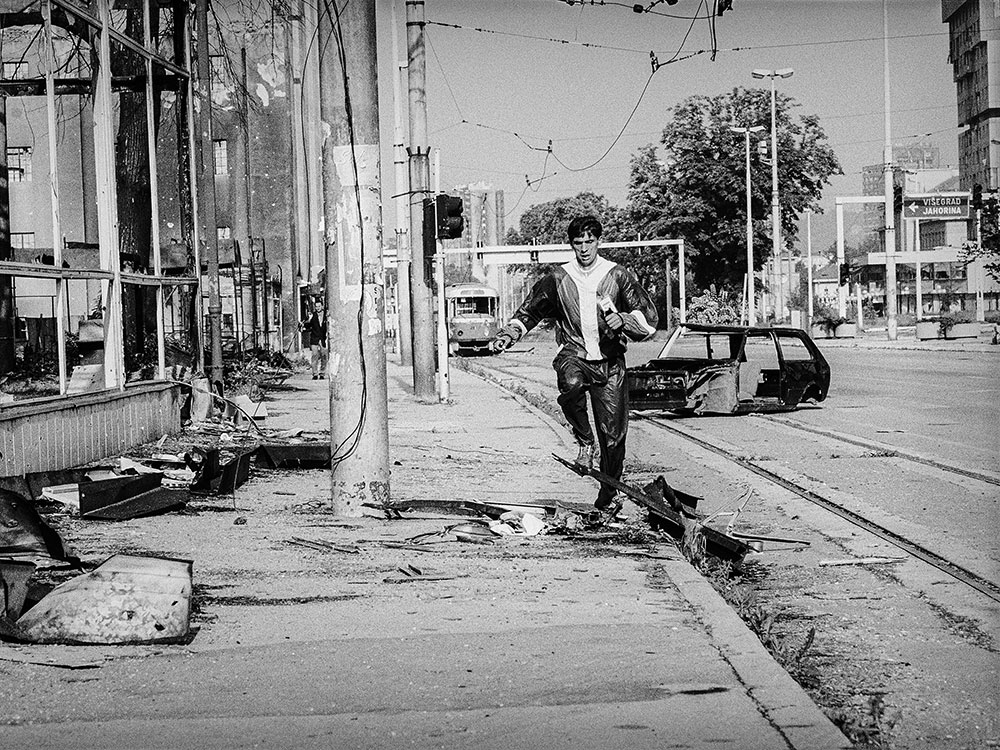Images of war.
Text: Michelle Isler
Bridges in ruins, empty streets, people running: A Basel historian asked herself whether photographs from the Bosnian war (1992–1995) share a common visual language. Her findings are revealing.
T he way in which a war is portrayed in the media is not a matter of chance. Motifs are chosen, details are singled out, particular settings are emphasized – and others are ignored. Since its emergence in the 19th century, photographic war reporting has followed recurring patterns, many of them inspired by history painting. Nadine Freiermuth Samardžić of the Department of History devoted her dissertation to patterns and peculiarities of this sort in photographic depictions of the Bosnian war. To this end, she examined a collection of around 5,000 photos from German-language illustrated magazines.
Shots fired from windows
And there was plenty to find. One recurring perspective she identified was the camera angle aimed over a gunman’s shoulder. Another observation relates to the photographic depiction of war scenes in civil settings, with many photos showing snipers aiming their guns out of office or bedroom windows. The combination of these settings with the “over-the-shoulder perspective” vividly illustrates how the fighting did not unfold on some uninhabited battleground, but in the midst of everyday life. Photographers were never far from the action.
“These photos dominate and are characteristic of the reporting on the war in Bosnia at the time,” the researcher summarizes. “These war images, similar to the ones we see today from Syria, are nothing like those from the war in Iraq a short time before.” In fact, much of the media reporting on the Gulf conflict, dubbed a “cyberwar”, consisted of computer images depicting high-tech warfare. People were rarely shown. “This has the effect of making the Bosnian war seem to belong to a different era. The pictures feature themes reminiscent of the Spanish civil war, or the Second World War: simple weapons, motley-clad militias, ground warfare,” says Freiermuth Samardžić.
Shock value
Drawing a connection between these observations and Balkanist and Orientalist discourse, the researcher realized the extent to which existing narratives shape war reporting. These narratives include the myth of the Balkans’ backwardness and propensity to violence. Much of the region’s cultural heritage was consumed by violence; fighters posed for the cameras as brutal gang leaders wearing balaclavas and displaying skull and crossbones. The media eagerly seized upon these images of primitive societies. “Certain magazines even printed pictures of executions,” the historian recounts.
This lack of scruples is revealing of the situation in which press photography found itself in the 1990s. At the time, many German-language magazines were fighting for survival in the face of declining readership. The ethically dubious pictures undermined the enlightened self-image that photojournalism had cultivated over the course of the 20th century, which bore little relation to “shock photos” of this sort.
Focus on Sniper Alley
Finally, in pictures from Sarajevo, Freiermuth Samardžić identified a specific aesthetic in the portrayal of the Bosnian war. The capital city, under siege for 1,425 days, featured prominently in news reports. In particular, the area known as Sniper Alley received worldwide attention, giving rise to a typical motif: people running from sniper fire.
Although the press were not immune to the dangers of the bullet-sprayed street, they could be sure of finding enticing subjects for their photographs there. In Sniper Alley, the “decisive moment” required for a good photo according to Henri Cartier-Bresson was repeatable. For most people in Sarajevo, visiting relatives, fetching water or going to work were all impossible without crossing this main street.
As a result, people venturing onto Sniper Alley were exposing themselves both to the sniper’s crosshairs and the photographer’s viewfinder. Freiermuth Samardžić found a number of such paradoxes in the photographs of the Bosnian war – such as the anachronism between the brutal war and Europe’s modern perception of itself. Aside from the violence, the photos also depicted a city setting with urban architecture and infrastructure. “In this way, they created an experiential world that was easily recognizable to the western media,” the researcher explains.
However, this setting is broken by the visible signs of war, such as streets reduced to rubble and burnt-out cars. These dramatic images circulated in the global media – but were never seen by the besieged population of Sarajevo itself. Another paradox: Things that were impossible for locals could be obtained with relative ease by the press, who could arrange to drive or fly in and out of the war zone as they pleased.
Running away from the war
Among the thousands of images she examined, there is one photograph in particular that distils many aspects of her research, says Freiermuth Samardžić. The picture by the Swiss photographer Thomas Kern, published in “Magazin” in 1994, shows a man running in the streets of Sarajevo. The twist: As the caption reveals, the subject is Islam Dzugum, a marathon runner pictured while training. Dzugum would run up to 35 kilometers every day, and had to constantly change his route to avoid the snipers.
“The photographer gave the image a double meaning,” the researcher says, explaining that while the picture makes use of the familiar theme of the daily struggle for survival in a city under siege, it also exploits the motif’s ambiguity: The story behind the image is not what the viewer expects after seeing countless similar pictures. “In a sense, this man is also running away from the war – though not merely as a victim, but as an active subject: an athlete in a war zone.”
More articles in the current issue of UNI NOVA.

